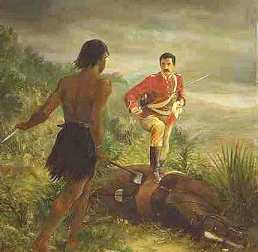Taranaki again unsettled the British.
In 1864, Lt/Col Warre demolished a pa and ordered Captain Loyd, with some militia, into the field to destroy rebel crops. Loyd and seven men were killed.
As the King movement had failed, a new religious cult had been borne from it's disappointments and failures - the Pai Marire ("good and gentle") movement, created by Te Ua Haumene.
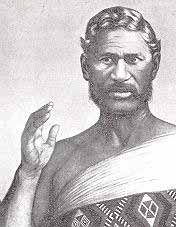
The Pai Marire blended the Bible, and Maori myth, and the followers, circling a pole called a nui, would call "hau, hau" - the British soon came to call the movement the Hauhau.
Utu, or revenge, and nationalism, were important to the Hauhau, and they believed that they could drive the Pakeha from New Zealand. In fact, it was held that the Archangel Gabriel (image below) had promised this, and that Loyd's head was to be paraded through the North Island, to show Maori that the Pakeha could be destroyed.

The Hauhau attacked Sentry Hill, but were shot to pieces - they had believed that they were immune to musket balls.
Matene Rangitauira headed to Wanganui, but the local iwi refused passage - a battle was fought at Motoua and Matene lost his life there.
In 1865, General Cameron arrived at Nukumaru, 15 miles out of Wanganui, with a force of 2,000 troops. His objective was to occupy the large Waitotara block of land.
The Ngati Ruanui tribe there were refusing to hand over the block, and the British sought to gain access to this rich coastal land.
The Hauhau commanded Weraroa pa, and were well fortified. Von Tempsky, who had remained on active service, arrived with Forest Rangers, and negotiated a surrender by the Hauhau, but this did not eventuate. Over many months, the British and the Hauhau skirmished, but essentially little else happened.
Having learnt to his dismay that the Hauhau could spring from the bush and skilfully pick off his men, Cameron took to the beaches - he was known scornfully to the Maori then as 'the lame seagull'.
Governor Grey came to the Wanganui region, took command of an entirely colonial force - not using any British soldiers - and overran the pa at Weraroa.

Prisoners were escorted to Wellington (image above) where they were interred on a ship - many escaped.
The Hauhau then laid siege to a new redoubt built at Pipiriki, on the Wanganui River, but the commander, Major Willoughby Brassey, floated pleas for help, written in Latin and put into bottles, downstream.
The relieving forces drove off the Hauhau, but in Taranaki the rebels were having more luck, ambushing and attacking various British columns
Major General Trevor Chute, arriving from Australia, took command, and joined by Major Von Tempsky and his Rangers in early 1866, marched into the field, to overrun Okotuku pa, and then Putahi pa. He then marched towards Mount Egmont, and a Hauhau stronghold, Otapawa.
Otapawa fell, and Chute marched on to New Plymouth to demonstrate that control of the region was his - not the Hauhau's.
Chute eventually came across, and arrested, Te Ua, the prophet, at Opunake and sent him to Governor Grey in Wellington. The Hauhau then threw up a leader who would prove the Maori were a formidable foe - Titokowaru would prove the match of the British generals (next page)
To their credit, both Cameron and Chute were disquieted by the actions of the Government in using armies to enforce land grabs, describing it as an 'iniquitous job'.
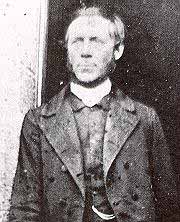
The year before, in 1865, at the Bay of Plenty, Reverend Carl Volkner (image above) had been killed by Kereopa te Rau of the Arawa, one of the disciples of Te Ua, after the clergyman had been rightfully accused of spying for the Government.
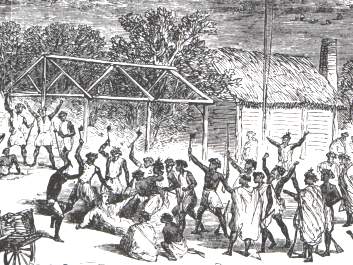
This act, and the barbarism of chopping his head off, and eating his eyes, enraged Governor Grey, and he sent Capt Luce, on "HMS Eclipse" to Opotiki to find, and arrest, Kereopa.
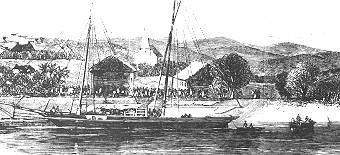
Kereopa instilled fear - he did not take prisoners, and those who were captured were gruesomely killed.

Luce was unsuccessful, but the hunt was on.
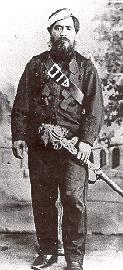
Major Ropata (above) of Ngati Porou, caught Kereopa some seven years later, and executed him, but until that time, the forces of the Government were constantly skirmishing with the Hauhau.
Again, no decisive battle, once and for all, established whether the Hauhau or the Pakeha ruled - but at one point 400 rebel prisoners were taken at Waeranga and deported to the Chatham Islands.
Many men who were serving in these British regiments, on active duty in New Zealand, elected to stay in the new country instead of returning home.
These men were to become a colonial force which would replace the regiments, and in the particularly troublesome areas of the Bay of Plenty and Wanganui/Taranaki, were singlemindedly tested by the Hauhau.
New Zealand.org.nz Homepage here
